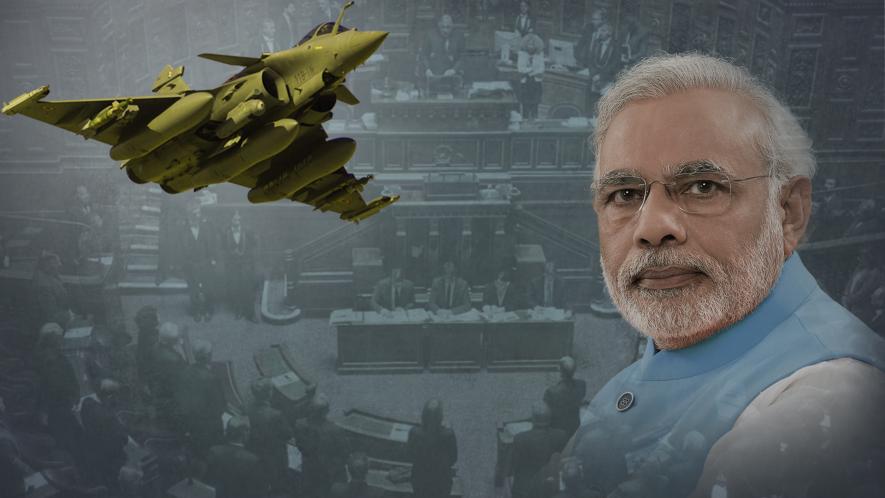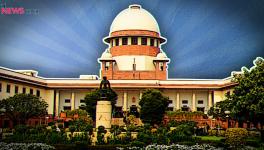Rafale: Do French Senate Documents Nail Modi’s Lie?

At a time when the Narendra Modi government is trying its best to spin more stories to save face on the controversial Rafale deal, new information coming out of France, some of which is already there in the public domain, raises some questions.
The “Rafale judgment” of the Supreme Court of India, in para 19 says, “The stalemate resulted in the process of RFP withdrawal being initiated in March 2015.” The apex court was referring to the Request for Proposal (RFP) for 126 MMRCA (medium multi-role combat aircraft), in which Dassault was selected, and with whom negotiation was being carried out till announcement on Rafale made by Prime Minister Modi on April 10, 2015. The line regarding stalemate seems to have been quoted from an unsigned and undated ‘note’ submitted by the Government of India. In the note, which has been placed in public domain, the Modi government told the court in para 18: “As the contract negotiations reached a stalemate and RFP compliance could not be ensured, the process for RFP withdrawal was initiated in March 2015 and RFP for 126 MMRCA was finally withdrawn in June 2015.”
In this submission, the latter part is true because the 2016-17 report of the Parliamentary Standing Committee on Defence states ”The RFP for procurement of 126 MMRCA was formally withdrawn on 24th June 2015”. The Rajya Sabha was informed of the same by former Defence Minister Manohar Parrikar towards July-end 2015. The government’s statement that “the process for RFP withdrawal was initiated in March 2015”, therefore, seems untrue, and an afterthought to cover-up Modi’s unilateral decision to announce the deal with France for 36 Rafale aircraft in flyaway condition.
On June 10, 2015, there was a meeting of The Committee on Foreign Affairs, Defence and Armed Forces held in the French Senate. The minutes of the meeting mention Senator Jean-Pierre Raffarin, who was the Chairman of the Committee, as saying: “As for India, the decision to purchase 36 Rafale was made during the visit of the Prime Minister of India. The technical discussions to conclude the agreement are taking place in best possible conditions.” The sentence “the decision to purchase 36 Rafale was made during the visit of the Prime Minister of India” is very important because it suggests that the French side was not aware of such a discussion before that. And clearly points at the unilateral decision taken by PM Modi.
Minutes of the meeting of the same Committee held on October 1, 2013 mention: ”For India, the RAFALE is part of an Indian aircraft fleet that already has its own equipment list, which requires aircraft adaptations. For Qatar, on the other hand, it is very close to that of France, which gives more flexibility for production management.” This point clarifies that the so-called “India-specific enhancements” were nothing new added by the Indian Air Force for this particular deal, as many people try to argue, but were a stated requirement in the 2007 RFP.
On June 24, 2015, Dassault Aviation CEO Eric Trappier was in the French Senate, answering questions by senators on a discussion related to “Military programmes and other provisions related to defence (of France) from the year 2015 to 2019”. Senator Raffarin, who held different positions in the Senate, such as Deputy Speaker, Chairman of the Committee on Foreign Affairs, Defence and the Armed Forces, Vice-Chairman of the Committee on Economic Affairs, asked Trappier “Mr President, it is a pleasure to see you again, the day after the success of the Paris Air Show. This is very important for all of us. The commission was very attentive to your activity. The major Rafale sales contracts of 24 each to Egypt and Qatar, as well as the materialisation of 36 aircraft deal with India, confirm the competitiveness of this product. You may also tell us about the progress of the dialogue with India.”
In his detailed reply, Trappier said: “Negotiations are going on with India. The current contract is to deliver 36 produced in France against the 18 initial aircraft under the MMRCA contract. With regard to the additional 90 aircraft to arrive at the 126, as envisaged initially, nothing is certain today. But, in order to meet the requests of the Indian authorities’ "Make in India", it would be better to manufacture these future orders locally there.”
The above statement clarifies two things. a) As the Modi government told the Supreme Court, they did not initiate the process to withdraw the RFP for 126 aircraft in March 2015. If they had, as the CEO of Dassault Aviation, Trappier would have been aware of that decision because India was negotiating with Dassault, not the French government for 126 Rafale under the RFP. b) Trappier’s statement gives the impression that he was expecting India to place the order for 90 more Rafale to reach the six squadron they needed, as envisaged in the MMRCA RFP, and was not aware of the cancellation of the same till June 24, 2015. This suggests that the Modi government misled the Supreme Court and probably this was one of the reasons for the submission of an “unsigned and undated” note.
In the same Senate meeting, Senator Joel Guerriau, after congratulating Trappier for the contracts, asks: ”...The agreement with India asks for the work to be shared with their HAL company. What is it and what would be the consequences for our national development?” Though this question seemed intended to weigh the loss of employment opportunities in France, Trappier did not give any specific answer to it. Rather, he did not answer that question at all.
Another document from the French Senate throws up some interesting figures. In the “Budget bill for 2019: Equipment for defence Forces”, annexure 1, titled “Major weapons programmes funded in the 2019 budget” says the “cost of carrying out the (Rafale) programme estimated at € 47.7 billion as on 01/2018. This cost corresponds to a target of 286 Rafale.” The break-up of this 286 aircraft is explained in this document. It says, “Before taking into account the project of LPM 2014-2019, the total cost of the program for the state amounted to € 46.4 billion at the price level of 2014 and a unit cost (excluding development cost) of € 73 million for Rafale B (for 110 aircraft), € 68 million for Rafale C (for 118 aircraft) and € 78 million for Rafale M (for 58 aircraft).”
A Fact Sheet by the National Defence and Armed Forces Committee on the draft finance law for 2016 pertaining to the defence sector, in Volume VII says “In 2015, France won its first Rafale export contracts. The first, which came into force was signed with Egypt for 24 Rafale with associated armaments, for a total amount of 5.2 billion Euros (this amount also includes the sale of a FREMM).” FREMM is a frigate and its price (French version) is estimated to be around €860 million.
The Modi government says they ordered 36 Rafale in flyaway condition to meet the “emergency requirement”. But the aircraft will not start to come before September 2019, if everything goes according to plan. And the India-specific enhancements (ISEs) will become fully operational only by September-October 2022, says an article published in The Economic Times on January 20. By the time these ISEs becomes fully operational, France will start inducting the F4 (next upgraded version) of Rafale! The same article, quoting Defence Ministry sources, says India already paid Rs 34,000 crore to France and another Rs 13,000 crore will be paid in a few months for the 36 Rafale. This means, out of the Rs 63,870 crore (as per today’s exchange rate), the Modi government would be paying 73.5% of the total transaction value before even a single aircraft is delivered! But they can not pay less than Rs 15,000 crore to HAL (Hindustan Aeronautics Ltd) for the works they have already done!
The government, in its written reply to the Supreme Court, argued that they could not disclose the price of the deal because it would impact national security and, for some strange reason, the SC accepted that argument. In para 25 of its Rafale judgement, it is stated that “The Chief of the Air Staff is stated to have communicated his reservation regarding the disclosure of the pricing details, including regarding the weaponry which could adversely affect national security.” Dassault Aviation has given the details of the weapons Rafale can carry in its website. There are enough French Senate documents that give details of the weapons associated with Rafale. This document is just one of them. The 2007 RFP asked for almost the same - (a) Active BVR missiles (b) All Aspect Air to Air Missiles (c) Anti Ship Missiles - 100km Range (d) Medium Range Missiles - 200 km Range (e) Stand-off PGMs - 40km Range (f) LGBs (g) Gun Ammunition (h) Anti-Radiation Missiles.
The details published in Dassault’s website make it clear that the French company won’t be transferring the fighter jet manufacturing technology to India in any way. Under the headline, “India – A Critical Challenge”, the company states that it “started the construction of a plant in Nagpur, State of Maharashtra, in 2017. This facility represents the largest single foreign investment in India’s defence sector. It will first make parts for the Falcon 2000, then gradually ramp up production over the next five years.”
A clarification published by the French Embassy is more telling on to the Inter-Governmental Agreement (IGA) that the Modi government had signed with France. It reads “The intergovernmental agreement signed on 23rd September 2016 between the French and Indian governments for supplying India with 36 Rafale aircraft concerns the obligations of the French government solely with regard to ensuring the delivery and quality of this equipment.” So, are we to understand that the French government will not be responsible if Dassault or any of its partners fail to supply spare parts or any other components required for the maintenance of Rafale? If that is the case, then Modi government seems to have completely ignored the objections raised by IAF and the Ministry of Law and Justice on the IGA.
In a nutshell, the French Senate documents reiterate that a) the decision to purchase 36 Rafale was a unilateral decision taken by PM Modi. b) There is no difference in the specifications and weapons IAF requested in 2007 RFP and in Modi government’s deal. c) The withdrawal of RFP was not initiated in March 2015, as claimed by the Modi government in the Supreme Court. d) By the time the India Specific Enhancements will be fully certified and operational, Rafale will have the next upgrade to F4 standard and e) India didn’t do an emergency purchase, as projected by the government, and is still paying nearly 75% of the total contract value in advance, while not paying HAL’s pending dues.
Ravi Nair broke the story of the Rafale scam and is writing a book on the subject. The views expressed are personal.
Get the latest reports & analysis with people's perspective on Protests, movements & deep analytical videos, discussions of the current affairs in your Telegram app. Subscribe to NewsClick's Telegram channel & get Real-Time updates on stories, as they get published on our website.
























